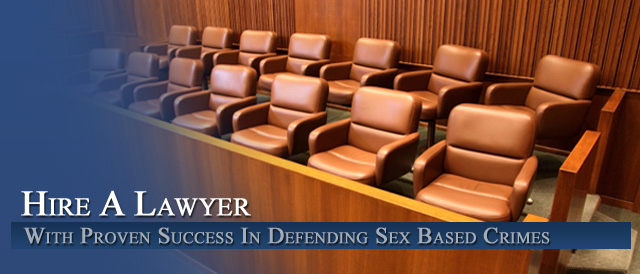




Understanding the Juvenile Sex Offender and Treatment Modalities in Colorado
It has been my life experience that studying each area of the kind of Colorado Criminal case I am defending – exhaustively – makes a better advocate. Learning how the so called “experts” view juvenile sex offenders is an ongoing task of almost continuous study.
I present the information on this website and on this page in that effort to educate present and future clients or for those who simply want to also study this field.
Legal definitions aside, experts in the field agree that sexually abusive behavior—juvenile or otherwise—is contact that is sexual in nature and that occurs without consent, without equality, and as a result of coercion, manipulation, game-playing, or deception.
Causes and Patterns
There are a host of theories that have been proposed to explain why some children and teens sexually abuse others. Although there is no clear and simple formula for how this happens —sexual offending behaviors are extremely complex—the theory most widely accepted today is known as the “learning theory,” which holds that sexually abusive behavior in children is linked to many factors, including exposure to sexuality and/or violence, early childhood experiences (e.g., sexual victimization), exposure to child pornography and advertising, substance abuse, heightened arousal to children, and exposure to aggressive role models/family violence.
Early theories about children who sexually abuse others proposed that these individuals move through a predictable progression. In this cycle, an event causes a negative emotional response in the youth. The youth attempts to gain control of this response but fails. He then feels anger and rage, which in turn lead to thoughts of retaliation and fantasies of overpowering another, which lead to an assault.
More recently this cycle has been criticized as too rigid—interviews with offenders reveal that life problems (at school, in the family) and any number of thoughts or feelings can trigger an offending behavior.
Traits of Offenders
A significant amount of research has been conducted on juvenile sex offenders. Although these efforts have revealed much solid information about this population, each of these children is unique. Perhaps the only statement that is reliably true for all juvenile sex offenders is that the traits and progression of behavior can vary tremendously from one individual to another.
That said, it is known that nine of ten juvenile sex offenders are male and that juvenile sex offenders often commit their first sexual offense before age 15 and even before age 12. It is also well known that juvenile sex offenders are found in every socioeconomic class and every racial, ethnic, religious, and cultural group.
According to the Center for Sex Offender Management (1999) the following are other common traits among juvenile sex offenders.
- Difficulties with impulse control and judgement
- High rates of learning disabilities and academic dysfunction (30% to 60%)
- Mental illness: up to 80% have a diagnosable psychiatric disorder
A minority of sexually abusive youth also have deviant sexual arousal and interest patterns. “These arousal and interest patterns are recurrent and intense, and relate directly to the nature of the sexual behavior problem (e.g., sexual arousal to young children).”
Two Types of Offenders
Clinical observation and empirical research indicate that, as is the case for adult sexual offenders, juvenile sexual offenders fall into two groups: those who sexually abuse children and those who victimize peers and adults. These two groups, as reflected in the chart on the following page, have clear differences not only in the victims they select, but in their offense patterns, social and criminal histories, behavior patterns, and in the treatment they require.
Treatment
Since it was first identified as a serious problem, there have been tremendous advances in the treatments available for children and teens who sexually offend. In 1983 there were only 20 programs in North America for juvenile sex offenders; today there are well over 1,000 worldwide (Ryan, 2000).
“The majority of juvenile sexual offender treatment programs have generally adhered to a traditional adult sex offender model. Standard interventions include the teaching of relapse prevention and the sexual abuse cycle, empathy training, anger management, social and interpersonal skills training, cognitive restructuring, assertiveness training, journaling, and sex education” (Hunter & Longo, In press).
Although treatment is widely acknowledged as helpful to juvenile sex offenders and as an important component in the prevention of future sexual offenses, additional studies of the effectiveness of different methods are required.
Treatment can be a difficult hurdle for juvenile sex offenders. In one study, as many as 50% of youths entering a community-based treatment program were expelled during the first year of participation, most often for failure to comply with attendance requirements or therapeutic directives (Hunter, 2000). As the next section explains, this failure to complete treatment can increase a youth’s chances re-offending.
Recidivism
A common belief about juvenile sexual offenders is that even after treatment, most will offend again. Hunter (2000), citing the research literature, finds “no compelling evidence to suggest that the majority of juvenile sex offenders are likely to become adult sex offenders. . . . . juveniles who engage in sexual aggression frequently cease such behavior by the time they reach adulthood”
Juveniles who participate in treatment programs have sexual recidivism rates that range between 7% and 13% over follow-up periods of two to five years. Research indicates that recidivism for nonsexual offenses is much higher among juveniles (25–50%) (Hunter, 2000).
Youths participating in treatment have lower recidivism rates than either adult sex offenders or untreated juvenile sex offenders. In an analysis of eight separate studies, Alexander (1999) found that while adults had re-offend rates that averaged 13%, juveniles who participated in offense-specific treatment had a recidivism rate that averaged 7.1% in a 3–5 year follow-up. Worling (2001), in a large-scale study that examined data from across Canada, found that only 5% of youths who underwent treatment were charged with another sexual offense within six years, compared to 18% of the youths who did not participate in treatment (Ryan, 2000).
The Over-identification of Juveniles as “Sex Offenders”
Over-identification of adolescents as sex offenders is a growing problem in a time of public clamor for get-tough policies on crime.
“According to Paul Isenstadt – a Colorado expert on Juvenile Sex Offenses and called upon over the years by our firm as an sex offender evaluator states:
“Right now, one of my main concerns is that as a result of the whole emphasis on sex offender sex offender n. generic term for all persons convicted of crimes involving sex, including rape, molestation, sexual harassment and pornography production or distribution. In therapy, we’re seeing a large, large number of juveniles being pulled into the legal system for inappropriate behaviors that historically may not have been considered law-violative but now are automatically charged.”
‘Take, for example, an adolescent who touches someone at school inappropriately. When a complaint is made to the school principal, the police officer assigned to the school will be notified. Automatically that student is going to be charged with a sex offense. In contrast, adults are going to have a lot more review of the facts before a case is filed. We have what I believe is somewhat of a net widening in the juvenile area.’
Tools to Evaluate Colorado Juvenile Sex Offenders: Ann Freeman and Paul Isenstadt
Ann Freeman, also an expert in this field, and a juvenile sex offender evaluator in Colorado Springs (previously with the Colorado Division of Youth Correction) agrees with Isenstadt.
Ann refers to a youth under correctional supervision because he dropped his trousers and did a “mooning” on a school bus….from all available evidence a basically normal kid who committed a stupid youthful prank.’
“He was put on formal probation by the court for 2 years,”and while I certainly don’t think that his behavior was appropriate, this is a kid who’s never misused his power in any other way. For him to be adjudicated as a sex offender isn’t right.”
Mr. Isenstadt in support of his position – relies on studies which demonstrate that 80% of juveniles who engage in sexually inappropriate behavior do not become adult sex offenders.
To identify those adolescent sex offenders at greatest risk of recidivism recidivism both Mr. Isenstadt and Ms. Freeman use two structured, empirically guided juvenile risk assessment instruments: the Juvenile Sex Offender Assessment Protocol (J-SOAP) and the Estimate of Risk of Adolescent Sexual Offense Recidivism (ERASOR ERASOR Estimate of Risk of Adolescent Sexual Offense Recidivism ) are very helpful when used in conjunction with the clinical interview.
The J-SOAP uses 26 predictive factors divided into four scales. Two of the scales–sexual drive/preoccupation and impulsivity/antisocial behavior–are static or fixed in nature. The other two, which involve more dynamic, changeable items, are the intervention and community stability/adjustment scales.
Mr. Isenstadt said impulsivity/antisocial behavior and sexual preoccupation best distinguish the 20% of kids at highest risk for repeat sexual offenses. “The kids I see who are most concerning are the ones with histories of criminal behavior, exposure to domestic violence, and caregiver inconsistencies–10 foster homes, 6 residential treatment centers. Many of these kids have been acting out sexually aggressively, often also committing property crimes. And watch out if you work with kids for a history of conduct disorder Conduct Disorder Definition’
Conduct disorder (CD) is a behavioral and emotional disorder of childhood and adolescence. Children with conduct disorder act inappropriately, infringe on the rights of others, and violate the behavioral expectations of before age 10 and juvenile antisocial /an·ti·so·cial/ (-so´sh’l)
1. denoting behavior that violates the rights of others, societal mores, or the law.
2. denoting the specific personality traits seen in antisocial personality disorder.
Ms. Freeman noted that the J-SOAP is useful in children as young as age 10 in terms of their cognitive development. Since many 12- and 13-year-old sex offenders function at age 8-9 cognitively, rendering the J-SOAP inappropriate, the first step in evaluating a juvenile sex offender always has to be a determination of the youth’s developmental level. For boys developmentally younger than 10 and for girls, Ms. Freeman tends to use the ERASOR, which has more fluid, dynamic predictive factors.
Other Articles of Interest:
- Colorado Juvenile Sex Offender Case Issues
- Colorado Sex Crimes Defense – Understanding the Role of Denial
- Colorado Criminal Sex Offender Laws – The Impact of Denial (of the Crime) in Colorado Sex Offender Cases and the Use of the Polygraph in Denier Cases
- Colorado Sex Crimes: Glossary of Terms Used in Sex Crimes Cases
- Colorado Criminal Laws – Sex Offender Label And Treatment Requirements Without Ever Being Convicted of a Colorado Sex Offense – the S4 Label












